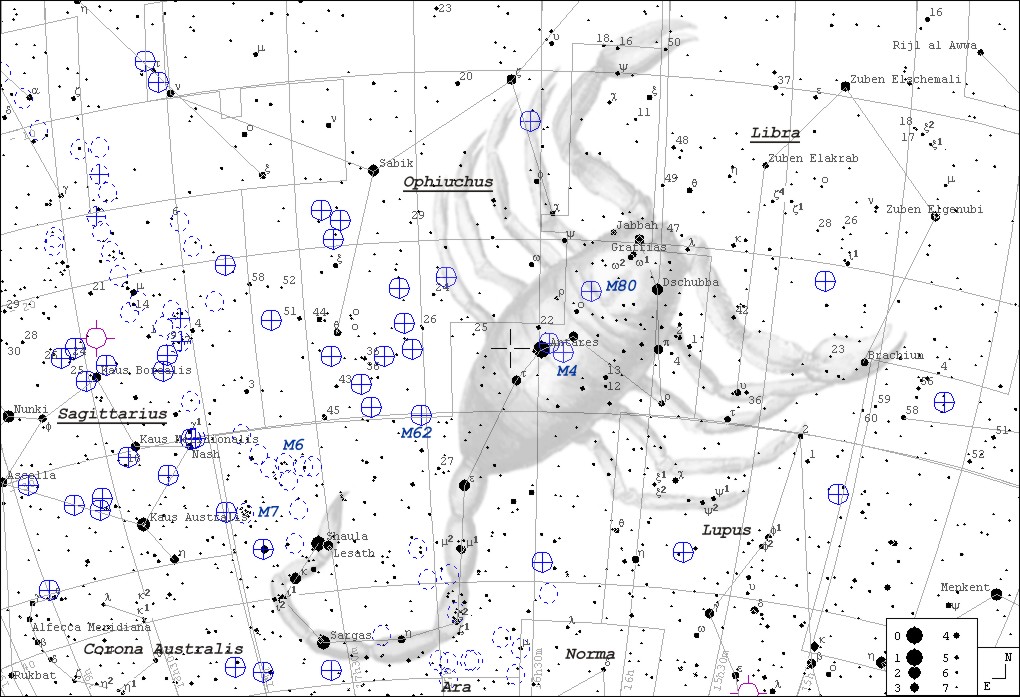the second star to the right, and straight on till morning
 The constellation Scorpio
The constellation Scorpiocontains one of the "short list"
candidate suns -- 18 Sco --
around which extraterrestrial
life may exist.
Reuters
Saturday 18 February 2006
Astronomers get shortlist
of possible ET addresses
by Maggie Fox, Health and Science Correspondent
ST. LOUIS (Reuters) -- Astronomers looking for extraterrestrial life now have a short list of places to point their telescopes.
They include nearby stars of the right size, age and composition to have Earth-like planets circling them, scientists said on Saturday.
But cuts in federal funding mean that private philanthropists who pay for the bulk of their work may find out first when and if extraterrestrial life is discovered, the astronomers told a meeting of the American Association for the Advancement of Science.
Margaret Turnbull of the Carnegie Institution of Washington released her "top 10" list of potential stars to the meeting. They will be the first targets of NASA's Terrestrial Planet Finder, a system of two orbiting observatories scheduled for launch by 2020.
"There are 400 billion stars in the galaxy, and obviously we're not going to point the Terrestrial Planet Finder ... at every one of them," said Turnbull.
So, on behalf of the space agency NASA and the now independently funded Search for Extraterrestrial Intelligence, or SETI, she narrowed down the list to stars that could have planets with liquid water orbiting them.
"We want to see these habitable planets with our own eyes," she added. So the star cannot be too bright, or it will obscure the planet.
Variable stars, which grow hotter and cooler, probably would not be conducive to life, so they were thrown out, as were stars that are too young or too old. Some are too gassy to have spawned planets like Earth, which contains a lot of metal. Others have massive companions whose gravity could interfere with the steady conditions needed for life to evolve.
TOP 10 LIST
Turnbull's top 10 list includes 51 Pegasus, where in 1995 Swiss astronomers spotted the first planet outside our solar system, a Jupiter-like giant.
Others include 18 Sco in the Scorpio constellation, which is very similar to our own sun; epsilon Indi A, a star one-tenth as bright as the sun; and alpha Centauri B, part of the closest solar system to our own.
"The truth is when looking at these so-called 'habstars,' habitable solar systems, it is hard to really rank them. I don't know enough about every star to say which one is the absolute best one," Turnbull said.
Jill Tarter of the SETI Institute, set up after U.S. government funding for the program was cut, said the current budget threatens other astronomical programs.
She said research and analysis budgets were cut by 15 percent in the fiscal year 2007 budget proposed this year by U.S. President George W. Bush.
[Vleeptron footnote: Big-ass expensive foreign war going on.]
"In the case of astrobiology, the cut is to 50 percent of what it was in 2005," Tarter told a news conference. "We are facing what we consider an extraordinarily difficult financial threat."
She said NASA once had a policy of what to do, whom to call, and how to announce the news if someone detected a signal of intelligent life from space.
"Today it is in fact a group of very generous philanthropists who will get the call before we get a press conference," Tarter said. They include Microsoft co-founder Paul Allen and Microsoft chief technology officer Nathan Myhrvold.
Carol Cleland of the University of Colorado argued that astronomers are limiting themselves by looking for planets that closely resemble Earth.
"I actually think we ought to be looking for life as we don't know it," Cleland told a news conference.
She said life on Earth is all so similar -- based on DNA made up of specific building blocks -- that it is likely to have had a single origin. Life elsewhere may be built from different ingredients, or structured very differently, she said.
© Reuters 2006. All Rights Reserved.


2 Comments:
a peter pan fan! glad to know it.
Now where's the next bloody worm hole ?
On the other hand....look out to the stars !! This could be the Forbidden Planet, inhabited by The Thing. It Came From Outer Space, they will say someday and it could even be Earth Vs The Flying Saucer. Them ! might attack us. A strange Species will try to turn us into Blobs according to Plan 9. Something Wicked this Way Comes !
Could well be The Day of the Triffids or even The Day the Earth Stood Still and we will all end up in.....The Twilight Zone.
Beware !!!Look to ....the STARS !!!
(Am I watching too many old sci-fi movies?)
Post a Comment
<< Home